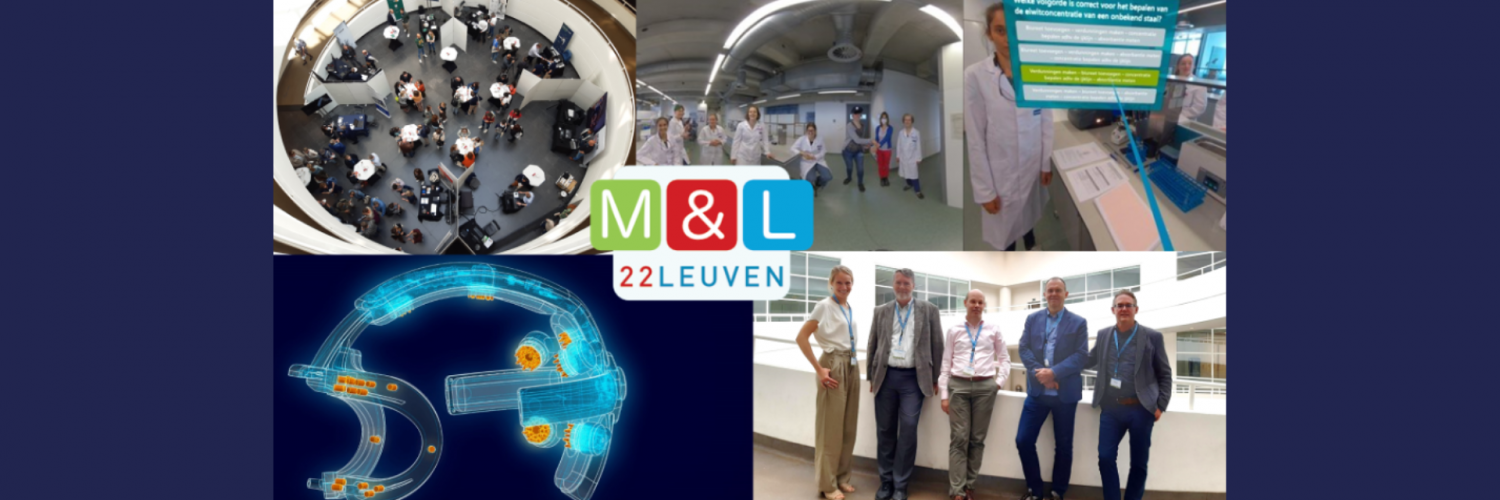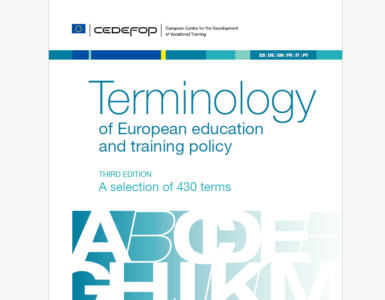By Zac Woolfitt, Inholland University, The Netherlands
‘What will the university of the future look like?’ We explored this theme at the Media and Learning conference on 2nd and 3rd of June in Leuven, Belgium. After two years hosting the conference online, Media and Learning could celebrate its 10th anniversary in person. It was good to meet up with colleagues and friends again. (Disclosure – I am on the conference advisory committee and was involved in presenting and moderating during the conference).
This report covers the sessions I attended in person. Unfortunately, I cannot do justice to all the great sessions I missed. These are covered in the post conference website. This report is grouped by themes and not in chronological order.
Editor’s note: Long Read – Reading time 15 – 20 minutes.
- 1 – Seizing our moment in history… going digital and staying human
- 2 – Teaching and managing interactions in the Hybrid Virtual Classroom
- 3 – Supporting academics during educational innovation
- 4 – Policies and practices related to creating new learning spaces
- 5 – Instructional Video: Two Truths and a Lie
- 6 – Can Extended Reality go mainstream?
- 7 – Tour of the KU Leuven Video Studio
1 – Seizing our moment in history… going digital and staying human
The switch to online teaching during the pandemic loosened established structures. Our recent return to the classrooms and lecture halls was a unique moment in the history of education. A chance to create something new. What lessons did we learn during the pandemic? How can we apply these to reinventing our universities of the future? How will higher education evolve and what forms will it take in the years to come? The conference themes examined; interactive environments, XR and AI, social media, re-purposing media resources, effective media production, policies and practices, open/accessible resources, assessment, innovative practices, video in research and centres for teaching and learning.
Tine Baelmans, Vice-Rector of Educational Policy at KU Leuven welcomed us to the conference. Tine fully understands the relevance of the Media and Learning association. KU Leuven has multiple campus locations and has a well-developed strategy; ‘Going digital, staying human’. She reminded us how important it is to be together again physically at this conference, to engage, network and laugh. The community of experts present were ‘strengthened through the pandemic’. It is time to shift from ‘rescuing’ to ‘reinventing’ higher education. To enhance learning interactions through digital media and multisensorial learning.
2 – Teaching and managing interactions in the Hybrid Virtual Classroom
Brian Beatty of San Francisco State University is author of ‘Hybrid-Flexible Course Design; Implementing student-directed hybrid classes’ and has been involved in organising hybrid classes since 2005. His university has 23 campuses and 500,000 students. Students need access to high quality education, which is equitable and inclusive, to participate and feel a sense of belonging. There should be multiple ways to access education. If you book a restaurant, you can do that in person, or online. Education should give students this choice and flexibility through Hyflex (Hybrid + flexible) courses.
Traditional, single-mode classes, limit some students due to access or travel issues. Brian’s position is that all parts of a Hyflex course need to be available, both online and offline. Students can determine their own learning path. If that is not the case, then the course is not Hyflex but multimodal. It is not realistic to strive for ‘the same experience’ in person and online. But there should be equivalence, in which alternate learning paths lead to equivalent learning outcomes. All live sessions should be recorded. Any content that is developed during discussions such as conversations in the class and questions, should also be recorded. A transcript of that discussion can then be made available to asynchronous students to review at a later stage, increasing accessibility. It is not sufficient simply to post class recordings for the asynchronous students. It needs to be (re)designed for more interactivity that can raise engagement. Motivated instructors need to actively develop social presence and student engagement, online or in person. There are three groups to teach to. Those in the class, those watching online, and those who watch it later. A competent instructor will be aware of these three audiences and make sure to address them individually. Teaching in the Hyflex context is complex with a steep learning curve. It needs to be ‘orchestrated’ and supported. Post pandemic students want to return to the campus, but also want flexibility to manage their own time better. Is higher education ready for the greatly increased access to the world and increased competition? Looking at Rodger’s curve of technology adoption, each group of the curve needs to be addressed with a specific message. From early adopters to laggards.
Student and teacher experiences with hybrid teaching and learning at KU Leuven
Annelies Raes of KU Leuven has been conducting research into the hybrid virtual classroom. One of the first literature reviews on this subject was published by her in 2020. It is a solid overview on the subject which I have referred to in my own research. During synchronous hybrid learning both on-site and remote students are connected and taught synchronously in what KU Leuven calls the “hybrid classroom” or “hybrid lecture hall”. The challenge for students is to feel connected and engaged and for teachers it is additional cognitive load and difficulty orchestrating the learning interactions.
With ten locations dispersed across Flanders, KU Leuven is a good candidate for technology innovation. Designing good learning spaces that can bring remote student and faculty together is important. The space between the lecturer and the student should also be carefully considered; from intimate, personal, and social to public space. Interactions in the first 4 meters are easier and can also build social presence.
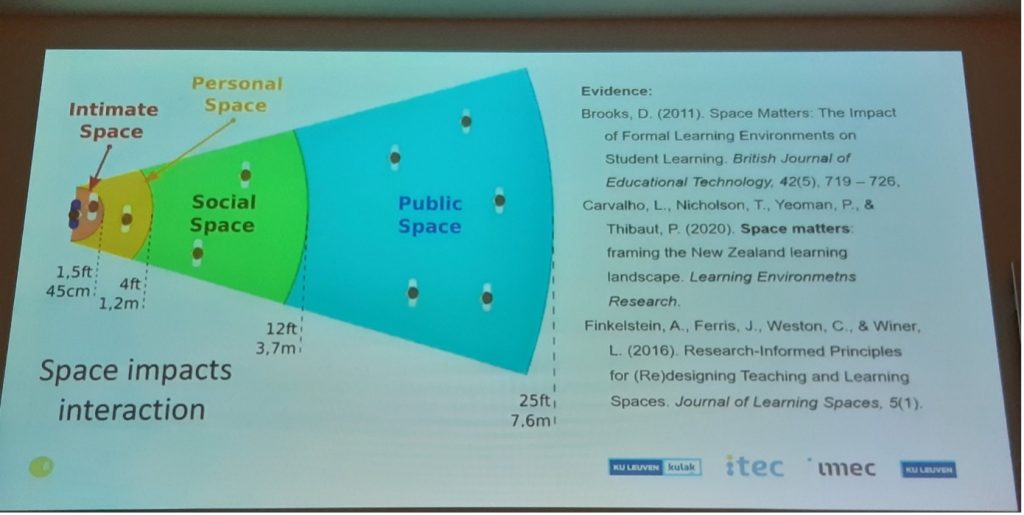
She quoted Seymour Papert ‘You can’t teach people everything they need to know. The best you can do is position them where they can find what they need to know when they need to know it’. So what choices when we decide where to ‘position’ the student, and how does this impact their learning? Different examples of room set-ups that can reduce the teacher-student distance were presented. In one example from Oregon, the teacher is in the middle of the room which brings more students into the ‘social space’. Where do we position our remote students? In the Edulab in Kortrijk, remote students are at the back of the room on screens facing the instructor. Remote students can be on the side of the class, or at the front facing the class, or at the front facing the teacher. Research was conducted into the influencing factors of engagement and learning in these new environments from a student and teacher perspective. Each learning setting has different levels of engagement; face-to-face, face-to-face but in a hybrid class, participating remote in the hybrid setting, participating remote. The lowest student engagement was for those participating remotely in a hybrid class. This should be addressed by academics when teaching to these groups. They used eye-tracking and other metrics to see students lose interest which can help in activity cantered design. There was no significant difference in conceptual understanding between remote and onsite students.
Annelies used the Activity-Cantered Analysis and Design (ACAD) framework when conducting the research. ACAD is used for understanding and improving local, complex, learning situations. A useful tool when examining learning in a hybrid contexts.

We should remember that it is the student activity at ‘learn time’ that leads to actual learning outcomes. These learning outcomes are influenced by 1) the allocated tasks which are epistemically designed elements, 2) by the socially situated aspects such as groups, teams, and roles, 3) by the ‘set design’, the physical situation such as tools, artefacts and room layout and facilities. In the hybrid virtual classroom, it is important to take all these factors into consideration. To remember that what the student does at ‘learn time’ determines the learning outcomes, not only the technology and physical physical/online spaces. There is a difference between what the teacher has in mind when planning the education (intended/designed curriculum) and what the students actually do (experienced/lived curriculum).
Annelies’ upcoming research is titled ‘Teaching through collaborative problem solving to make teaching more interactive, student-based and future proof.’
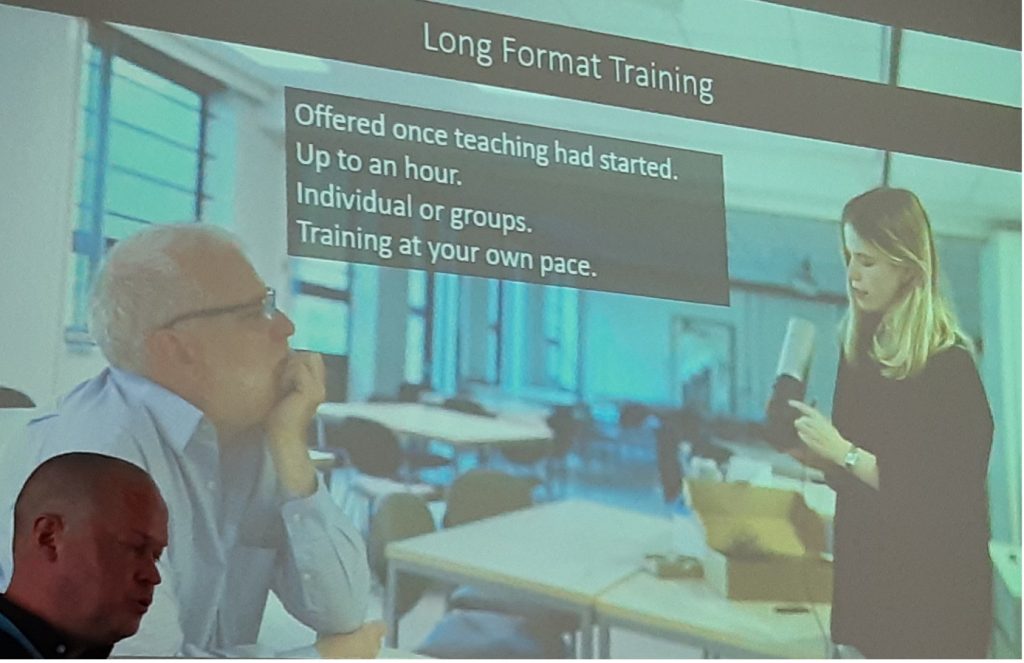
Teaching in these hybrid settings is complex from a pedagogical and technical perspective. How do you train all your staff at short notice to teach in these technology rich learning spaces? Stuart Phillipson and Rachel Willder explained how the University of Manchester employed student ambassadors to train 1,100 faculty in two weeks, on how to teach in the Hybrid Virtual Classroom (Hyflex or dual delivery). During the pandemic, 350 rooms were equipped for dual delivery teaching so that students could choose to follow classes in person or online. There are 3,500 teaching activities per week and 43,000 teaching events per semester for the 17,00 students in the faculty of humanities. Qualified support staff were not available in sufficient numbers. A top-down strategic decision was taken to train staff using students.
Student Ambassadors (SAs) were paid 14 Euros per hour to train faculty. Academics signed up for the scheduled 15-minute training sessions. In the library, 10 rooms were allocated for students to demonstrate the equipment, set up ‘learning lines’ and train their own professors. The training took place in September 2021 just before the semester started. Students explained equipment, trouble shooting, camera angles and software. The SAs could be booked by faculty for the start of each class, to help set up and facilitate the zoom sessions. How to connect all devices, correct zoom settings and adjusting audio. They could stay for the entire session, run break out rooms, monitor the chat and communicate to the academic teaching. Key topics were curated on Padlet’s. This took the logistical burden off the professors. In evaluations of the process, they found that academics were more confident, and happy after the students trained them. The humanities students usually worked on music, drama, and art. But they developed their soft skills and became competent solving hardware and software issues. This enhanced their communication skills, problem solving skills, adaptability, time management and they gained wider experience of the university. One student said, ‘The most important skill I feel I developed over this year was to be quickly adaptable as per the needs of each lecturer – whether this was helping someone with a full understanding of technology, or someone with no prior knowledge of teaching via a blended learning style’.
What next for the Hybrid Virtual Classroom?
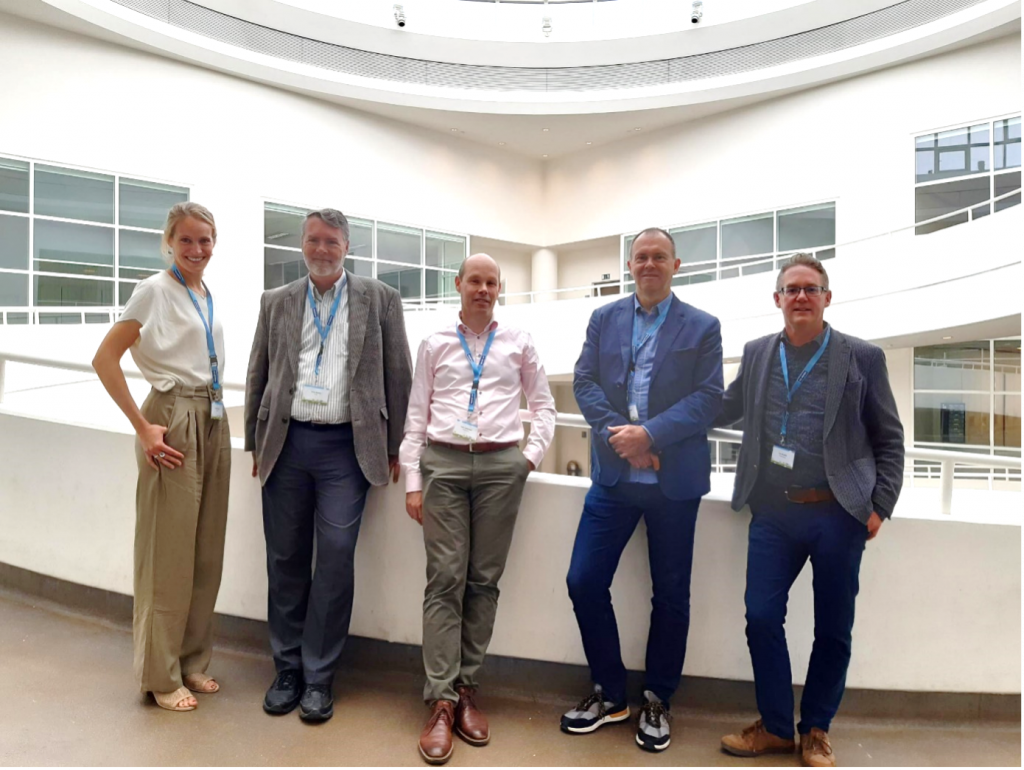
Brian Beatty moderated a discussion about the hybrid virtual classroom. The panel included Annelies Raes, Jelle Scheurleer (a colleague from Inholland) and James Rutherford of University of London. I was glad to join as the fourth panel member. Some key points of our valuable discussion are summarized here (with thanks to colleague Ewald Edink for his notes!).
Giving lessons in a hybrid context is complicated and asks a lot. You don’t know in advance how many students will be online or in the classroom. Variables include the number of cameras, microphones and position and angle of screens. The total number of students, the learning goals to be achieved and the level of the students. Creating a good connection between those online and in the classroom is one of the main challenges. Some students are glad to have the option to follow online for health or travel reasons, but students need developed self-regulation in order to make the right choice. Recording the lessons allows access later. It may be an option to start first-years with face-to-face classes, and to move to hybrid once they have developed study skills. Brian starts his courses with a lesson that is only available face-to-face, then one only online which allows students to understand the differences and hopefully to make good choices. When asked how to design a Hyflex course, Brian referred to his book (see below) and provided a set of guidelines based on learning outcomes. My suggestion was to consider very carefully how the synchronous learning time is used. If we ask students to join live in person or online, then the interactions must be valuable and enriching. If the class can be covered as a pre-recorded set of instructions, then it should be. James Rutherford writes a blog on his experiences and records a series of podcasts. We are in the process of evaluating how to change the pedagogy and the traditional role of the lecturer is changing. Are we moving beyond the ‘sage on the stage’ to ‘guide on the side’ transition? I suggested the term ‘moderator in the middle’ and James mentioned the ‘mentor in the centre’. How much flexibility for options and control should students be given? Jelle has been teaching in this context since 2016 on the master’s course he runs. He shared his own experiences into this (covered in more detail here from a previous M&L webinar.
But many questions remain. How do we help students make a good choice about their participation mode in class and should we limit flexibility? Since a good teacher needs an audience should we give incentive to students to come to class? It can be a challenge to teach to empty classrooms or screens with cameras off. How can we design the classroom experience, so it attracts more students? Has the hype around hybrid-flexible teaching and learning subsided? Are we moving toward a productive future? Has the “why this is needed” been fully established? Where is this being challenged?
We only covered some of these questions so we will have to continue next time.
3 – Supporting academics during educational innovation
How does higher education support academics with the developments in technology and evolving learning spaces and who is responsible for this? Deborah Arnold is National & International Projects Coordinator at AUNEGE France. She completed her PhD this year which focuses on Digital Education Leadership Literacies in Higher Education and the mindsets, attitudes, and behaviours of Higher Education leaders with respect to digital education. Slides from the presentation are here.
Professional and academic staff in higher education, often interact through a ‘third space’ which is more conceptual than physical, where pedagogy and technology intersect. There is a complex interplay between leadership, academic and professional roles while universities strive to improve the way media and technology are used to support learning and teaching. Professionals should claim legitimacy for their roles and skillsets to further digital education. It is not the structures or job titles that matter, but how we work and who we work with. Northampton University is a good example of a new campus built on an active blended learning concept. It is library, research institute combined with social and coworking spaces. Students, staff and the rector all hot-desk. Academic staff, educational developers, learning technicians and students are integrated into a social mix. The physical space is designed to support these interactions. The Leuven learning lab is another valuable example.
In the ‘third space’, knowledge is created about learning and teaching, media and technology. About each other, learners, ways of working together, cultures and values. Building relationships with people is as important as knowing how the technology works. Skills are needed as coach, facilitator, conduit, catalyst, and complex collaboration champions. Each of us can make a start by knowing our own pedagogical and technological profile. Deborah invited us to make our own techno-auto-ethnography to visualize the different skills and roles we have developed through our career. I plan to make one for my next presentation.
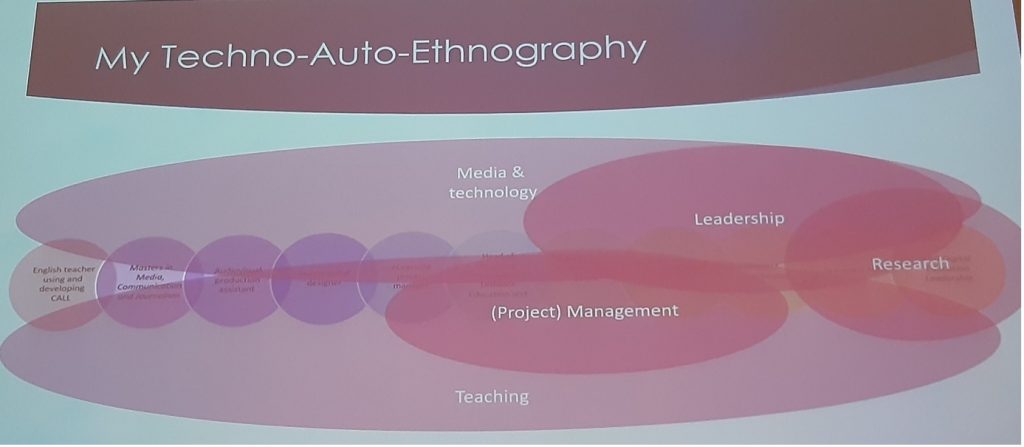
4 – Policies and practices related to creating new learning spaces
How are institutional policies and practices influencing the fundamental re-thinking of university spaces? Sonia Hetzner, of Friedrich-Alexander-University discussed ‘The New Normal and Future Learning Spaces’. We need flexibility, control, and social contact. Post pandemic, 70% of staff who responded wanted to return to campus, while 87% of staff respondents want a mix of online and offline. Different learning spaces being developed were for Large Events (lecture halls), ‘Co-Learning and Co-Working (flexible learning spaces), Individual Learning (sound-proof concentration booths), E-Exam locations (exam rooms online or at campus) and flexible media studios. Learning spaces should allow you to present, investigate, create, exchange, develop and interact. We need to transform didactics to ensure graduates have suitable future skills. Learning can move from instruction to construction, from passive consuming to co-creation of meaning and understanding. Academics can support students on their learning journey.
Big lecture rooms determine how we teach. Redesigning the space is an opportunity to redesign learning. In surveys, students indicated that a very important physical space was the lobby just outside the lecture hall. It should be flexible, a lounge-like foyer with comfortable seating. This allows discussion, socializing exchange of ideas, before and after the lecture. However, there are consequences to giving a lot of freedom to students. Letting them decide whether to attend class in person, or to sleep a bit longer and watch the lesson from home. Students don’t always know what is best for them and need ‘scaffolding’ and support to make the right choices for their learning.
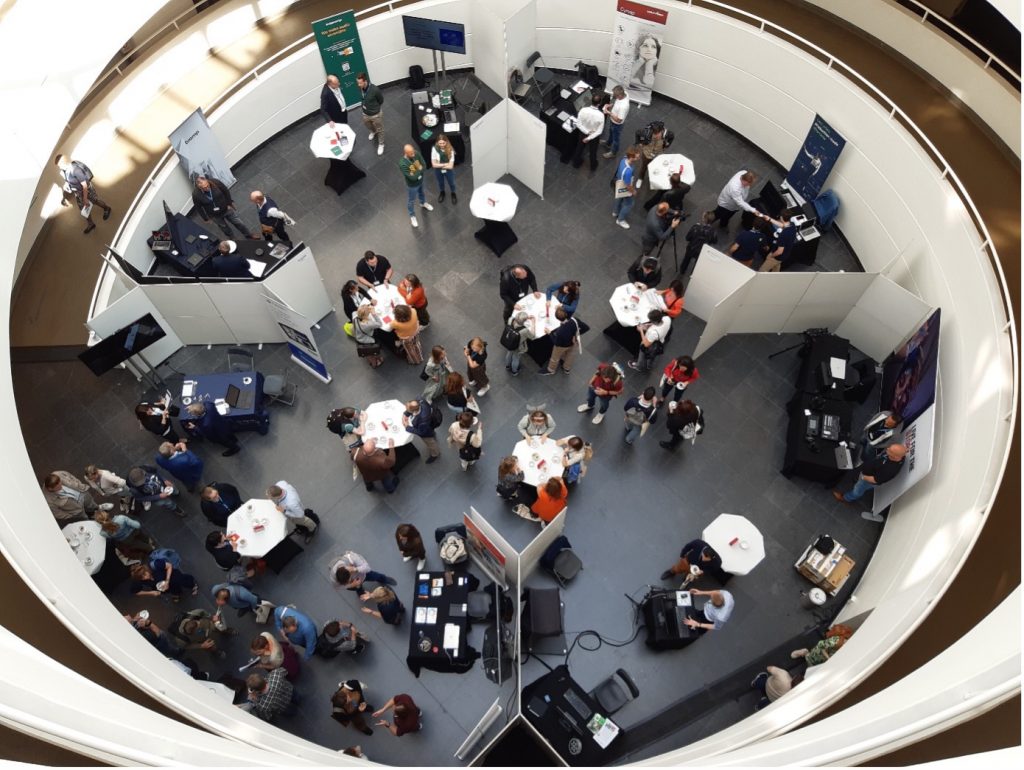
Marieke Pieters (professional development) and Piet Bonte (multimedia coordinator) of KU Leuven explained how they design and investigate learning spaces for hybrid synchronous learning from a learning lab perspective across their 10 campus locations in Flanders. There are different learning spaces for different learning goals and activities. They aim for students not to feel a difference between online and offline. Academics are supported with technology staff and room operators want an easy-to-use system. It is important to keep track of how engaged students are and what is influencing their engagement. Pre-pandemic, in 2020, their Hybrid Classroom set-up won the EUNIS award for best AV enabled education space. I visited the location in June 2018 and wrote about it here. They are experimenting with different and better cameras, more screens, and ways to install the technology, and to keep it affordable. It can also be used to connect two classrooms of students, with a teacher online, as a multi location concept.
5 – Instructional Video: Two Truths and a Lie
Erin Crisp of Educause in the USA is a leader of educational change, an expert in instructional design and assessment. As chief education officer she leads strategic online courses for all ages. Is there a correlation between the production quality of an educational video, and the level of engagement? Does co-viewing educational video lead to learning gains? Is it true that educational video rarely has a negative impact on learning? Erin categorised educational video into four types: the recorded lecture, the demonstration, the scenario, and the explainer animation. On average, educational video leads to better learning outcomes compared with other methods and rarely leads to negative outcomes. Co-viewing videos has the highest impact. The Universal Design Guidelines for Learning is a ‘framework to improve and optimize teaching and learning for all people based on scientific insights into how humans learn’. This can support our video creation process, along with an understanding of some of the key fundamentals of evidence-based decisions in education. Videos are strong when used to demonstrate concepts and teach skills, not just facts. Videos of 6 minutes are optimal in certain contexts, after which attention drops off. Although that cannot be applied to all educational video. Spending more money on video production does not result in better learning. And there are good examples of how to communicate via video. Mark Rober is a Nasa Engineer who has more than 22 million subscribers on YouTube. Kids love the videos and don’t even realise they are learning. ‘Authenticity is what matters. Teachers should be themselves and not over-produce slick videos. Include your pet in the video and share aspects of your personal life.’
I agree with Erin that being genuine and authentic is important. However, I do have concerns about sharing too much of your personal life (e.g., your children and home environment). If it impacts the privacy of others, then it should be carefully thought through. Striking a balance is important.
What to do with all that video? Store or delete?
I moderated a session with Marco Toffanin of the University of Padova, Rüdiger Rolf of Osnabrück University, and Sylvia Moes of the Vrije Universiteit. Most institutions have created a large stockpile of educational video. But how do we manage it and when do we delete it?

Marco has 5 Petabytes of storage in Padova, but is that enough? He took us through the various stages of the flowchart they use. First decide if the video content meets the minimal quality standards. If not, can it be adjusted? Is it up to date and does that matter? Can it be split into chunks, tagged and a quiz added? Can the document be used for a collection or research? Once you work through this flowchart, you can make a decision. 1) Archive the video, add a clear title and tags, and store it. 2) Considering deleting it. This framework helps to make this choice.
Rüdiger explained how German Universities are using Opencast at a federal level to categorise and store video in specific platforms. Opencast is a free and open-source video management system for universities that facilitates automated lecture recording and integration in the IT infrastructure. This allows universities to own their content and the costs are transparent. They are trying to increase the amount of re-used video (currently about 9%). Much video still remains hidden in each university space.
Sylvia is developing a national portal for Open Learning Materials in the Netherlands. With a team of developers, she is working on the integration of Artificial Intelligence to search for learning materials that match user profiles of interest, linking content across repositories. She is part of the SURF community on Boundary Crossing. By using ‘elastic searching’ video content can be matched to student skillsets as described by their curriculum profiles. This allows for a much better re-use of educational video across institutions and platforms.
Wies ter Veld, European Sales Director of Mediasite, presented Vidable, their latest approach to video. It is a ‘collection of AI-powered video enhancement tools… that can deliver comprehensive and automated video transformation at enterprise scale’. There are new ways to add metadata to video, putting students at the centre. Engagement is important to keep students connected to the learning. Large universities have experienced first-hand how difficult it is to teach in the hybrid virtual classroom. Teachers find it complicated, interaction with students is not always possible if cameras are off and there remain some technical challenges. Many students want to get back to school but some campuses are restructuring. What do we do with all the video we record and is it ever watched? By automatically adding meta-data with AI, video becomes searchable. Higher education faces ‘budget uncertainty’, not knowing how much video will be recorded and needs to be stored, tagged and accessed. Students only want to watch ‘the important stuff’. Using advanced software can remove ‘dead space’ in live recordings. Non-native speakers can create a personal path to navigate with the automatically generated captions.
6 – Can Extended Reality go mainstream?
Thomas Ginn of Leiden University asked what is needed for XR (Virtual, Mixed and Augmented Reality), to go mainstream. I had met him in Leiden in 2020 when a European XR platform was being discussed. He said that if XR was mainstreamed, every course in higher education would feature at least one XR experience, and XR headsets would be as common as smartphones. We need further research to know whether XR is really useful or just a gimmick. It is time for XR to escape the gaming community. Production has to be simple and easy. The XR experiences must be readily accessible and good quality hardware available. As an example, Flanders recently ordered 1000 VR headsets.
However, there are some accessibility issues which need to be considered when designing in XR. To avoid shutting out sight or hearing-impaired students, or those in wheelchairs. Particularly when XR becomes mandatory such as a lab training module. Trust and privacy, and what happens to our data is also important. New technology means that large amounts of data are collected by the ‘big companies’ who don’t have a stellar reputation when it comes to data protection.
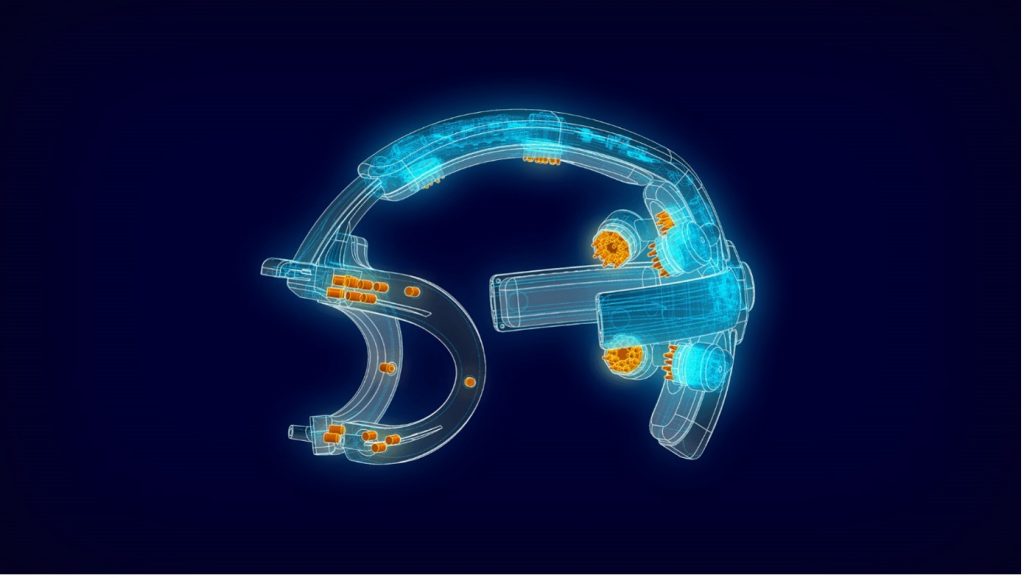
New headsets have sensors that collect data from your skin, face and eye movement, heart, body temperature and even your brain. Monitoring what you are thinking before you even know it yourself. Previously your experience might be mediated through a device, now you practically are the device!
Allowing your deeply private personal data to be collected while you are in an XR environment could be a bad move. Legislation is needed to ensure developments are ethical. We may be entering a post ‘log-in’ phase, in which you no longer need a password. Simply by moving around sensors will know its you.
If XR goes mainstream, our voices need to be heard.
Virtual Skills Laboratory in VR and the Medea Awards

I spent 15 minutes in Virtual Reality trying out the ‘Virtual Skills Laboratory’ (ViSkiLab) app. This app was a finalist for the 2022 Medea awards and ended up winning one of the prizes. The app was developed by Anne-Astrid Agten and Tula Verhalle of KU Leuven. When I talked to them, they told me that the pre-production of this VR experience took over a year of planning and scripting. The filming itself took only 3 days. I put on the VR glasses, plugged in the earphones, and grabbed the hand controls. I found myself in the first of four modules about standard practices when working in a laboratory. The app was realistic with 360 video of real students and an actual teacher. The tone was serious and when the teacher stared at me and asked me a question, I made sure I did my best to answer correctly. This app has already been used successfully by 400 students. Did students get bored spending such a long time in VR? They need to know the pass the test to continue with their studies so there is high intrinsic motivation. And you can take a break between each module. Many go all the way through in one go. I found it absorbing and the clear information, structure and navigability made it realistic and valuable. Now the module is made, many other students can come through this laboratory training. Another great example of how to use VR embedded in a course for assessment.
The winners of the annual Medea awards were announced in the Leuven town hall. 56 judges selected the best educational video projects. The winner was ‘Democracy vs. Sustainability’, a branched interactive story submitted by University of Bern. By going through the story, students gain insight into complexities of the world; ‘Should a food waste app be mandatory or voluntary? Should the majority of voters ‘out rule’ the minorities? Are political processes even compatible with sustainability?’.
At the conference I had a chance to talk to three colleagues who had travelled from Alberta for the award ceremony. Their film Black Lives Matter was a moving account of historical racism in Alberta and hearing the hard work they put in to create this film was inspiring.
7 – Tour of the KU Leuven Video Studio

For some inspiration on how things could be, I joined a guided tour of one of the KU Leuven video studios. The studio can be booked fully online. The first time you have a support staff member who walks you through the studio and some details. After which, most staff are able to run the studio on their own. There are a large number of tutorials available to explain various types of videos, when to use them and how to prepare for and make them. Each video comes with a pre-set template in PowerPoint which is then created in advance by the academic. Different slide formats exist so you can choose a green screen on one slide, then just text on the next, and an overhead camera to film your hands. All text in slide notes is automatically displayed on an autocue in the studio when you are recording. Without being aware of it, the academic prepares the script and self-directs the whole video. In the studio, it runs automatically with each slide click and is recorded in a sound-proof room with good audio, camera and lighting. The video file is available via a link once processed. This is an advanced and impressive approach to facilitating video recording for staff. The only way to get to use this is if you are a member of the KU Leuven staff. So, my try-out will have to wait!
In my own contribution to the conference, I shared ideas on ‘Assessing multi-media products at the Inholland Urban, Leisure and Tourism Lab in Amsterdam’.
So, what will the university of the future look like? We don’t know. But we find ourselves in a unique historical moment with the opportunity and responsibility to innovative the educational contexts of the future.
With thanks to…
The sponsors of the conference: Amberscript, Biamp, Canon, Mediasite, Panopto, Webclip2Go and WolfVision
Thanks for reading this far. If you’ve got questions, or suggestions for additions or adjustments to the text, please email me at zac.woolfitt@inholland.nl.

Author
Zac Woolfitt, lecturer and researcher, Inholland University in the Netherlands

